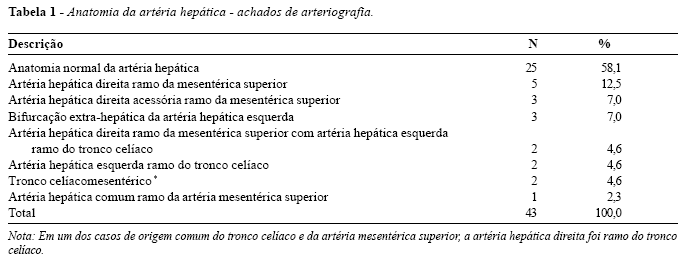BACKGROUND: Detailed knowledge of hepatic artery anatomy is essential for the success of living related liver transplantation. The purpose of this study is to describe the anatomy of the hepatic artery of donors and recipients of living related liver transplantation. METHODS: From March 1998 to September 2002, the study was retrospective (23 transplantations). From October 2002 to August 2003, the study was prospective (17 transplantations). We studied the hepatic artery anatomy of 80 consecutive patients (40 donors and 40 recipients) at the Liver Transplantation Unit of the Hospital de Clínicas of the Universidade Federal do Paraná and of the Hospital Nossa Senhora das Graças; 51 were male (27 recipients and 24 donors) and 29 female (13 recipients and 16 donors). The median age of the donors was 32.6 years and of the recipients was 36.3 years. Thirty-two recipients were adults and 8 were under than 15 years of age. RESULTS: Forty-three patients underwent abdominal arteriography and variations of the hepatic artery anatomy were found in 18 of them (41.86%). The most prevalent anomaly was the right hepatic artery arising from the superior mesenteric artery (12.5%; n=5). The anatomy of the hepatic artery was also evaluated at operation and variations were observed in 16 of the 80 patients (20%). The most common variation observed at operation was the right hepatic artery arising from the superior mesenteric artery (7.5%; n=6). CONCLUSION: It is concluded that the prevalence of hepatic arterial variations is high.
Liver transplantation; Living donors; Hepatic artery




